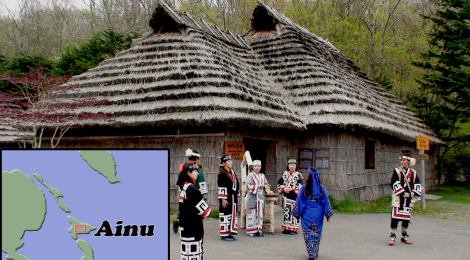
Ainu people
The Ainu people have always lived on Hokkaidô island (north of Japan), as well as the Kuril islands (now belonging to the Federation of Russia) and the southern half of Sakhalin island (now Russia too). This photo was taken in the Ainu village “Poroto kotan” in Shiraoi (Hokkaidô). Those people have Ainu ancestry and are dressed in the beautiful traditional Ainu kimonos with intricated patterns. The houses of this village are built in the old Ainu way.
The Ainu language is an agglutinative language with tendency toward polysynthesis (especially in its classical version), like other languages of the area (Chukchi, Inuit). It is also similar in structure and phonetics to Japanese (although it has more syllable-final consonants), but it is not genetically related to it or any other Altaic language: it is an isolate language, with no known cognates, spoken by only a handful of people today.
The Ainu and their language are probably related with the old Emishi people of Honshû island (Japan), and both might be traced back to the Jômon culture that populated Japan before the arrival of the Yayoi people (Altaic) from mainland Asia, and later Yamato civilisation. Japanese only colonised northern Honshû (displacing Ainu northward) from 17th century on, and Hokkaidô even later.
An Emishi tribe is depicted in the beginning of the famous anime “The Princess Mononoke”.

Recent Comments